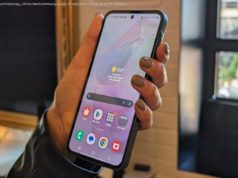Apple turned traditional phone design on its head with last year’s iPhone X, so it’s no surprise that this year’s version keeps the style going. The iPhone Xs brings a faster processer, more camera features, and even slightly better battery life.
The iPhone Xs is indistinguishable from last year’s iPhone X. As the “S” moniker suggests, it brings modest upgrades, but from what we’ve seen so far, you likely won’t want to upgrade to it over the iPhone X. That doesn’t mean it’s bad — it’s just the least interesting iPhone announced today because it’s so similar to last year’s model. It’s a compelling product for Android owners looking to switch, or for people looking to upgrade anything older than an iPhone 8. Let’s take a closer look.
The iPhone Xs has the same exact 5.8-inch screen as last year’s iPhone X, which for reference puts it in between the iPhone 8 and the iPhone 8 Plus. It’s currently the smallest of the new iPhone devices announced today — the iPhone XR has a larger 6.1-inch screen.
Out of all three new phones, including the iPhone Xs Max, we still love the size of the iPhone Xs the most. While some may have pined for a larger screen, we always thought the iPhone X’s screen struck a perfect balance — it wasn’t too big, making it comfortable to hold, and it still provided enough screen real estate to make watching videos enjoyable.
It looks exactly like last year’s iPhone X, which isn’t a bad thing at all. The back is minimal, with an elegantly-placed vertical dual camera.
We do wish the camera was flush on the back, but we’ve been wishing for this for quite some time. The glass — which Apple said is its “most durable” — feels nice to the touch, and the metal frame feels high-end. It now comes in gold, but silver and space grey options are still available. We love the look of the gold, and we think it’s the one to buy this year.
The buttons and Lightning charger remain where they were, there’s still no headphone jack, and the notch on the front carries the TrueDepth camera for Face ID. Apple claims this unlocking method is faster and more secure than ever before thanks to the new processor inside the Xs, but we were unable to test it.
The Super Retina HD OLED screen on the front supports Dolby Vision and HDR10, and it has the same exact 2,436 x 1,125 resolution as last year’s iPhone X (458 pixels per inch). The colors on the screen are realistic and well saturated, but it’s still the black levels that impress. We watched a few scenes from Ready Player One, and it looks realistic, as though we were very much a part of the virtual world. There’s also support for True Tone again, which adjusts the screen colors to match the temperature of the light in your surroundings.
The Xs Max is your best bet for a bigger screen, but we’re more than satisfied with this size. It’s easy to use one handed, which wins it points in our book. Apple also improved the water resistance on the device, bumping it up to IP68, which means you can leave it submerged up to two meters for 30 minutes.
Apple’s latest processor is the A12 Bionic, and it’s powering all the new iPhones. It includes a “next-generation Neural Engine,” which now has eight cores, and overall the chip can process 5 trillion operations per second. That essentially means the iPhone Xs Max can handle seriously intense computing tasks, and complete them faster than ever before. It may well be the most powerful smartphone available to date.
We played Elder Scrolls: Blades, a new game from Bethesda arriving later this year, and were blown away by the level of detailed graphics. It’s one of the best-looking mobile games we’ve ever seen, and it’s astoundingly smooth on this phone. Walking around and moving the camera is fluid, with zero stutter or lag.
We also tried an ARKit 2.0 game, which managed to seamlessly layer detailed graphics over the real world. Granted, all of this was done in a controlled demo, so we’ll definitely need to do further testing to see just how far the A12 Bionic processor can take us.
With the removal of the home button, you now need to use gestures first introduced with the iPhone X to navigate the operating system. It’s one of the best gesture systems we’ve used on a smartphone, and we didn’t run into any performance problems moving around the OS, or with opening and switching between apps. The iPhone XS Max runs iOS 12, which drops September 17, and you can read our guide on everything that’s new with the latest version.
Battery-wise, Apple claims the iPhone Xs can last up to 30 minutes longer than the iPhone X, which means you can expect about a day of use. That’s a little disappointing, as we’d have like to see a more substantial improvement here, but we’ll need to use the phone for a few days to see more precise measurements, and to see if Apple’s claims ring true.
Wireless charging is available again, but we’re still bummed to see no fast-charging cable included in the box — you need to buy it separately.
The iPhone Xs has two 12-megapixel cameras on the back, a standard f/1.8 lens and a telephoto lens with a f/2.4 aperture. The second lens is capable of up to 2x optical zoom, and it’s used for Portrait Mode photos. The camera sensor is said to be bigger than last year’s iPhone X, so you should see slight improvements overall.
Two key improvements enhance the camera experience over the iPhone X: Depth Control and Smart HDR. The former allows you to adjust the level of bokeh — or background blur — in Portrait Mode photos. It works really well, and it’s a great option if you want to tweak the photo exactly to your liking. It’s a feature we’ve seen on other Android phones before.
You also still get the same Portrait Lighting features from last year, but they should work better than ever thanks to the A12 Bionic. In the few tests we did, the camera was capable of identifying the edges around a subject accurately. We’ll need to do more testing to see how it fares.
We’re more excited to test Smart HDR. Essentially, it captures a lot of photos at the same time, and then with the help of the A12 Bionic processor, the camera chooses the best of each to create one photo with excellent dynamic range. That means you won’t need to worry about photos being too overexposed or underexposed in dynamic lighting conditions — but just right. The example photos we saw looked absolutely stunning, which is why we can’t wait to take the iPhone Xs out for a spin in contrasting lighting.
Apple also said you can record stereo sound with the camera, and there’s extended dynamic range, but we haven’t had a chance to see this in action.
The front-facing, 7-megapixel camera (with f/2.






